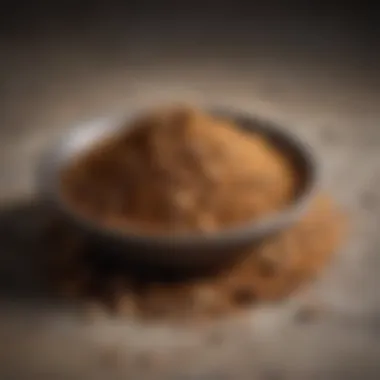Chai Tea Powder Recipe: A Comprehensive Guide


Recipe Overview
Chai tea powder is a cornerstone of South Asian culinary tradition. Creating this spice blend at home allows one to control the quality and freshness of ingredients, promoting a more robust flavor. In this section, we will outline the significance of chai tea powder, then explore the key components that define its unique taste.
Brief Summary of the Recipe
Making chai tea powder involves a careful selection of spices, tea leaves, and sweeteners, put together to create a harmonious blend. This powder can elevate any tea preparation, making it not just a drink but an experience.
Key Ingredients and Tools Needed
To create your chai tea powder, you will require the following essential ingredients:
- Black tea leaves (such as Assam or Darjeeling)
- Ground cinnamon or cinnamon sticks
- Ground ginger
- Cloves
- Cardamom pods
- Black peppercorns
- Sweetener (optional, brown sugar or stevia)
Additionally, gather these tools:
- Spice grinder or mortar and pestle
- Measuring spoons
- Airtight container for storage
Step-by-Step Instructions
Creating your chai tea powder is a straightforward process, yet it requires attention to detail and techniques to ensure a flavorful result.
Detailed Cooking Steps
- Prepare the Spices: Begin by measuring each spice according to your taste preferences. A standard recipe often includes equal parts of cinnamon, ginger, and cardamom, with cloves and peppercorns added for depth.
- Grinding the Ingredients: Use a spice grinder to finely crush your spices. If you prefer a coarser blend, a mortar and pestle can do the job. The goal is to release the essential oils from the spices while ensuring they are not too powdery.
- Combining with Tea Leaves: In a bowl, mix the ground spices with your black tea leaves. If using sweeteners, incorporate those at this stage as well.
- Storage: Transfer the chai tea powder into an airtight container. This will maintain its freshness and potency longer.
Tips for Successful Execution
- Experiment: Feel free to adjust the amounts of each spice based on your personal preference, or add new ingredients like nutmeg or dried orange peel.
- Quality Ingredients: Source high-quality spices and tea leaves for the best flavor profile.
- Freshness Matters: Always store your chai tea powder in a cool, dark place to preserve its freshness.
"Home-made chai tea powder not only enhances the taste but also embodies your unique flavor profile, reflecting personal preferences and culinary creativity."
By following these guidelines, you'll not only master the art of making chai tea powder but also enhance your overall tea drinking experience.
Prolusion to Chai Tea Powder
Chai tea powder is not just an ingredient; it is the essence of a tradition that spans centuries. The importance of chai within various cultures cannot be understated. In this section, we will explore the roots and significance of chai tea powder, providing a solid foundation for the guide ahead. Chai, which means "tea" in Hindi, suggests the substance of this beverage has always held a special place, both socially and nutritionally.
History of Chai
The history of chai can be traced back to ancient Indian beverage traditions, where herbal concoctions were used for medicinal purposes. Historical records mention that chai was enjoyed in various forms long before the introduction of tea leaves to India. The British East India Company's efforts in the 18th century played a pivotal role in introducing black tea to the Indian subcontinent. This led to the evolution of the chai we know today, blending black tea with spices like cardamom, ginger, cloves, and more. Each ingredient not only enhances flavor but also brings health benefits.
Cultural Significance of Chai
Chai holds a profound place in many households across India and beyond. It is more than just a drink; it is a catalyst for conversation, a staple during hospitality, and often consumed during daily rituals. In many Indian families, offering chai to guests is a sign of respect and warmth. Also, chai represents a fusion of cultural influences. Variants of chai have emerged globally, each reflecting local tastes and preferences, yet the core remained rooted in its Indian origin.
"In its simplicity, chai connects diverse communities and preserves a tradition woven into the fabric of daily life."
The understanding of chai tea powder extends beyond the culinary aspect. Recognizing its history and cultural roles helps appreciate the nuances of each cup brewed. This guide will assist you in mastering the technique of crafting chai tea powder, enabling you to embrace this rich heritage in your own kitchen.
Understanding Chai Tea Powder
Understanding chai tea powder is crucial, both for enriching one's culinary repertoire and appreciating its cultural heritage. Chai tea powder serves as a versatile base for making this beloved beverage. It combines flavors and aromas that cater to various palates and preference. Moreover, knowing the components and methods of creating chai tea powder invites individuals to explore its different potential.
What is Chai Tea Powder?


Chai tea powder is a blend of finely ground ingredients used to prepare traditional Indian chai. This mixture typically includes black tea, various spices, and sweeteners, all combined to create a rich, fragrant beverage. The term "chai" itself simply means tea in Hindi, highlighting the central role that tea plays in this preparation. The convenience of having a pre-mixed powder allows for quick brewing while preserving the complexity of flavors that characterize chai.
Key Ingredients of Chai Tea Powder
Black Tea Leaves
Black tea leaves are a fundamental component of chai tea powder. They provide a robust base, with a strong flavor that stands up to the potent spices. The most common type used is Assam tea, known for its malty character. This quality delivers a balanced mouthfeel, enhancing the overall drinking experience. Additionally, the caffeine content in black tea offers an energizing effect, which appeals to many chai enthusiasts.
However, the choice of black tea can vary. Darjeeling or Ceylon tea can be used for different flavor profiles. Each type of black tea brings unique characteristics to chai, affecting both taste and aroma. Thus, selecting the right black tea is essential for achieving the desired chai experience.
Spices
Spices are the soul of chai tea powder, infusing warmth and complexity to the beverage. Common spices include cardamom, ginger, cinnamon, and cloves. Each spice contributes a distinct flavor. For example, cardamom gives a sweet and floral note, while ginger adds spiciness and warmth. This combination not only enhances flavor but also provides potential health benefits.
The unique feature of spices in chai tea powder lies in their versatility. They can be adjusted according to personal taste or season, offering room for creativity. However, with so many spices available, it can be challenging to find the perfect balance. Some may find certain spices overpowering; hence experimentation might be necessary to create a cohesive flavor profile.
Sweeteners
Sweeteners play a crucial role in chai tea powder, balancing the spice and tea's bitter notes. Popular choices include sugar, honey, and jaggery. Each sweetener brings different flavors and textures. For example, jaggery imparts a rich, caramel-like taste, while honey offers floral notes. Incorporating sweeteners can elevate the overall experience, making the tea more enjoyable for those who prefer a sweeter profile.
Nonetheless, the choice of sweetener must align with dietary preferences. Some may seek sugar alternatives for healthier options. Hence there are diverse options available that allow individuals to control sweetness according to personal taste.
"The beauty of chai lies in its ability to cater to individual preferences, shaping each cup uniquely and meaningfully."
The Recipe for Chai Tea Powder
The preparation of chai tea powder is a crucial section of this guide. It serves as the practical application of knowledge gathered about chai's history, cultural significance, and its ingredients. The right recipe enables enthusiasts to recreate authentic flavors in their kitchens. This is significant for those who wish to explore traditional aspects of chai while also tailoring the flavor profile to their personal preferences. Crafting chai tea powder can be rewarding and enjoyable. It opens new doors to culinary experimentation. Moreover, homemade chai tea powder is free from preservatives, offering a cleaner alternative compared to store-bought varieties. Ultimately, knowing how to make chai tea powder not only enhances one's culinary skills but also deepens an appreciation for this beloved beverage.
Ingredients Needed
The ingredients for making chai tea powder are essential. They not only contribute to the flavor but also the overall health benefits of this beverage. The base typically includes:
- Black Tea Leaves: Assam or Darjeeling are good choices due to their robust flavor.
- Spices: Common spices include cardamom, ginger, cinnamon, cloves, and black pepper. Each spice adds depth and character.
- Sweeteners: Options like jaggery, sugar, or honey may be added. This really depends on personal taste and dietary preferences.
- Optional Additions: Some may choose to include star anise or nutmeg for variation. The choice of spices can reflect regional or cultural preferences.
Step-by-Step Preparation Method
The preparation method for chai tea powder is straightforward and accessible. Following these steps ensures consistency and quality:
- Measure the Ingredients: Gather your chosen black tea leaves and spices in the right proportions. It often helps to have a scale or measuring spoons handy.
- Toast the Spices: Lightly toast the spices in a pan on low heat. This enhances their aroma and flavor, making the chai tea powder more aromatic.
- Grind the Mixture: Let the toasted spices cool. Use a spice grinder or coffee grinder to finely blend the spices with the black tea leaves. Ensure the consistency is uniform.
- Store the Powder: Once grounded, transfer the chai tea powder into an airtight container. Ensure it is fully sealed to keep away moisture.
This method captures the essence of homemade chai tea powder and allows one to control the texture and strength.
Storing Chai Tea Powder
Proper storage of chai tea powder is vital to preserve its flavors and extend its shelf life. Here are key tips for storing:
- Airtight Containers: Use glass or tightly sealed plastic containers. This helps keep moisture and air out.
- Cool and Dark Places: Store the container in a cool, dark pantry or cupboard. Heat and light can degrade its quality.
- Label and Date: Always label the container and include the preparation date. This helps track freshness. Chai tea powder can last for up to six months under the right storage conditions.
By adhering to these guidelines, one can ensure that their chai tea powder remains as vibrant and flavorful as when it was first made.
Variations of Chai Tea Powder
Chai tea powder is not just a one-size-fits-all blend. It can be tailored to meet individual preferences and dietary needs. Variations of chai tea powder provide an opportunity to explore unique flavors and health benefits. They allow tea lovers to experiment with ingredients, creating a more personalized chai experience. This section explores three popular variations: Masala Chai Powder, Vegan Chai Powder, and Low-Sugar Chai Powder.
Masala Chai Powder


Masala Chai Powder is perhaps the most traditional form of chai mix. This variation incorporates a blend of spices, which gives it a rich flavor. Common spices include cardamom, ginger, cloves, and cinnamon. Each spice contributes not only to the taste but also to the aroma, elevating the overall experience of drinking chai. The specific ratios of spices can vary according to personal taste. This flexibility allows for creativity in the kitchen.
Furthermore, the health benefits associated with these spices can enhance your chai experience. For example, cardamom is known for its digestion-aiding properties, while ginger is often praised for its antioxidant benefits. Making Masala Chai Powder at home ensures that you can adjust the spice levels to your liking, making it both flavorful and beneficial for health.
Vegan Chai Powder
Vegan Chai Powder caters to those who prefer plant-based options. Traditional chai often uses milk, but this variation allows for complete dairy-free preparation. Ingredients like coconut milk powder or almond milk powder can be added to the mix. These alternatives do not compromise on creaminess or flavor.
In addition to being vegan, this variation is great for people who are lactose intolerant or looking for lighter options. Many find that plant-based milks add unique flavors to chai. For instance, coconut can impart a subtle sweetness that pairs beautifully with spices. Therefore, Vegan Chai Powder is a versatile and inclusive choice for chai lovers.
Low-Sugar Chai Powder
Health-conscious individuals may want to explore Low-Sugar Chai Powder. In this version, sweeteners are either eliminated or minimized significantly. Instead of sugar, natural sweeteners like stevia or monk fruit can be employed. These alternatives allow you to enjoy your chai without the added calories of traditional sugar.
Reducing sugar in chai does not mean sacrificing flavor. Adjusting the spice balance can create a satisfying taste that outshines the need for sweetness. This variation is particularly appealing to those managing blood sugar levels or seeking a healthier lifestyle without depriving themselves of flavorful beverages.
"Adapt your chai to your own health needs. Each variation can provide not only taste but also nutritional benefits."
Health Benefits of Chai Tea
Chai tea not only delights the palate but also provides numerous health benefits that deserve attention. The combination of spices and tea in chai creates a beverage that is rich in nutrients and has various positive effects on overall health. Understanding these benefits can enhance appreciation for chai tea and encourage smarter consumption.
Antioxidant Properties
Chai tea contains black tea leaves, which are a notable source of antioxidants. Antioxidants help combat oxidative stress, which is linked to various chronic diseases. The polyphenols found in black tea can lower the risk of heart disease and cancer by neutralizing free radicals in the body. Additionally, spices like cinnamon and ginger amplify these antioxidant effects. For those looking to boost their intake of antioxidants, chai tea offers a flavorful approach.
Digestive Benefits
Chai tea is often infused with ginger and black pepper, ingredients known for their digestive properties. Ginger aids digestion by promoting the production of digestive enzymes and can help reduce nausea and bloating. Meanwhile, black pepper increases the bioavailability of nutrients, making it easier for the body to absorb them. For people who suffer from occasional digestive issues, enjoying chai tea may provide relief. Moreover, the warmth of the beverage can soothe the stomach and promote gastrointestinal health.
Potential Heart Health Benefits
Regular consumption of chai tea could potentially benefit heart health. The combination of black tea and spices may contribute to lower cholesterol levels and improved blood circulation. Studies indicate that the catechins in black tea can reduce LDL cholesterol, contributing to better cardiovascular health. Furthermore, cinnamon has been linked to lower blood pressure. Therefore, including chai tea in a balanced diet can be a delicious way to support heart health.
"Incorporating chai tea into your daily routine not only offers a comforting taste but also provides remarkable health benefits."
As chai continues to gain popularity, understanding its health benefits can help individuals make informed choices. Incorporating chai tea into a daily routine not only serves pleasure but also fortifies one's well-being.
Serving Suggestions for Chai Tea
Serving chai tea properly enhances the drinking experience significantly. Different occasions call for various styles of serving chai, reflecting both tradition and modern trends. This guide will explore traditional and contemporary methods, offering insights that can elevate the home preparation of chai tea.
Traditional Serving Methods
In many cultures, how chai is served can be as important as how it is made. Traditional serving methods often emphasize simplicity and warmth. Chai is typically served in small cups which allows drinkers to enjoy it hot. In India, for instance, it is common to serve chai with pakoras or samosas, providing a delightful balance of flavors.
Pouring it from a height is a classic method, believed to aerate the tea, enhancing its flavor. The act itself becomes a performance of sorts. Consider also serving in clay cups, known as "kulhads," which add an earthy touch. The connection with tradition can enhance the appreciation of chai as not just a beverage, but a cultural ritual.
Modern Twists on Chai
Chai Lattes
Chai lattes are an imaginative twist on traditional chai. They incorporate steamed milk and can be topped with a sprinkle of cinnamon or nutmeg. This addition brings creaminess that softens the spice profile. The key characteristic of chai lattes is their versatility; they can be made with various plant-based milks, catering to those with dietary restrictions. They appeal to a broader audience, making chai accessible beyond its cultural roots.
While they may lack the strong, spiced flavor of traditional chai, chai lattes offer a comforting richness. The blend offers a unique experience, wrapping the drinker in warmth. It is an excellent choice for a relaxing afternoon or social gatherings, allowing guests to enjoy a familiar flavor while experiencing something new.


Chai Smoothies
Chai smoothies provide yet another innovative way to enjoy chai tea powder. This preparation involves blending chai with yogurt, fruit, and sometimes even protein powder. The unique feature of chai smoothies lies in their health benefits; they often come packed with nutrients from fruits and yogurt. It is a refreshing option, particularly for those seeking a quick, energizing breakfast or a post-workout snack.
Chai smoothies can be custom-made to suit personal taste preferences. However, the spice may be muted compared to traditional chai. The balance of flavors can get tricky, and it may take a few tries to perfect the blend. Still, the benefits of creativity and nutrient density offer a solid reward.
In summary, whether opting for traditional serving methods or modern twists like chai lattes and smoothies, there’s much to explore in the realm of chai tea. Each method offers distinct advantages, ensuring that there is a way to enjoy chai for everyone.
Troubleshooting Common Issues
When crafting chai tea powder, it is crucial to be aware of potential common issues that may arise during the preparation process. This section aims to address challenges related to flavor, especially in terms of spice levels and sweetness. Understanding how to troubleshoot these aspects can enhance the overall experience of enjoying chai tea. This practical knowledge will allow enthusiasts to adjust recipes to their personal preferences, ensuring a satisfying cup each time.
Adjusting Spice Levels
Spice is a defining feature of chai tea, influencing its complexity and warmth. However, not all individuals have the same palate. Consequently, balancing spice levels is essential when your chai tea powder does not align with your taste. If the flavor is too intense or not strong enough, adjustments can be made effectively.
One method to adjust the spiciness is to modify the amount of spices used during preparation. For instance, if you find that the ginger or cardamom is overpowering, reduce its quantity in the mix. Alternatively, if you want more heat, adding extra black pepper or ginger can elevate the taste.
Another factor to consider is the grind of the spices. Coarse ground spices may create a different flavor profile compared to finely ground ones. Adjusting the texture of your spice mix may help in achieving a more balanced flavor:
- For a milder taste: Use less potent spices or reduce their amounts.
- For a bolder flavor: Increase strong spices slightly, ensuring they do not dominate the blend.
Always keep in mind that flavor enhancement is subjective. It is crucial to sample along the way, as changes will accumulate and modify the chai's profile. Experiment to arrive at a blend that meets your unique taste.
Balancing Sweetness
Sweetness is an important component of chai, often determining whether the beverage feels comforting or sharp. Achieving the right level of sweetness can be a delicate balancing act, and it is influenced by both the type of sweetener and the quantity used.
If you find your chai too sweet, consider a few strategies to diminish this effect:
- Cut back on sweeteners: If you are using sugar or honey, reduce the quantity gradually. It is best to make small-scale adjustments after brewing a batch.
- Experiment with alternatives: Using naturally less sweet options like stevia or monk fruit can provide the desired sweetness with less sugar.
Conversely, if your chai lacks the desired sweetness, there are straightforward methods to enhance this:
- Increase the amount of sweetener: Note how the flavors change as you gradually add more.
- Add sweetness in stages: Allow the chai to brew longer before sweetening. This process can create a richer flavor.
It is essential to taste your chai throughout this process. Remember, what constitutes the perfect cup of chai is often subjective. You may find that varying the sweetness level elevates your chai experience—a result of personal preference.
"The beauty of chai lies not just in its ingredients but in the personal touch you bring to it."
Overall, troubleshooting and adjusting common issues will ensure that your chai tea powder fulfills your expectations. By taking the time to refine and experiment with spice levels and sweetness, you can perfect your chai tea recipe, tailoring it precisely to your liking.
Closure
In this article, we explored the intricate world of chai tea powder. The importance of this topic lies in its depth of culture and flavor, making it both relevant and intriguing for food enthusiasts. Understanding the recipe for chai tea powder is more than just learning to create a beverage. It offers insights into a rich history and a blend of tastes that can be customized to suit individual preferences.
Recap of Chai Tea Powder Recipe
The journey began with an introduction to the history of chai, showcasing its origins and significance in various cultures. We defined what chai tea powder entails and identified the key ingredients such as black tea leaves and unique spices that contribute to its character.
We provided a clear recipe, detailing the necessary ingredients and a step-by-step preparation method, ensuring readers can confidently create their own chai tea powder.
Additionally, we explored variations like masala chai, vegan options, and low-sugar alternatives. Understanding the health benefits certainly adds another layer of appeal, as it emphasized the nourishing properties of chai.
Lastly, we touched upon serving suggestions that allow for creative expression, ensuring there's an appeal for traditionalists and modern food lovers alike.
Encouragement to Experiment
Finally, we encourage readers to experiment with their chai tea powder recipes. Each spice blend and sweetener can dramatically alter the flavor. Adding an unexpected ingredient can lead to surprising results that redefine personal preferences.
Sharing these personalized creations can also foster community. Whether with friends, family, or through social platforms like Reddit or Facebook, engaging with others can offer new insights and ideas.
Exploring chai tea powder is an ongoing journey. Each cup offers both comfort and connection to a diverse culinary tradition. Embrace the process of learning, tasting, and adjusting flavors to create something uniquely yours.







